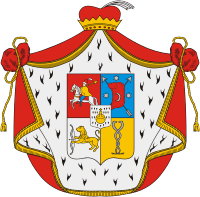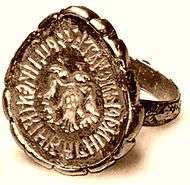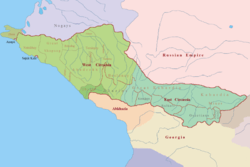Kabardians
| Total population | |
|---|---|
| (~ 1,000,000[1]) | |
| Regions with significant populations | |
|
590,010 (2010 census [2]) 498,702 56,466 | |
| ? | |
| 102,000 | |
| 43,000 | |
| 23,000 | |
| 15,000 | |
| 5,500 | |
| 1,300 | |
| 473[3] | |
| Languages | |
| Kabardian Adyghe dialect, Russian, Turkish, English, Arabic | |
| Religion | |
|
Predominantly Sunni Islam with small minorities professing Orthodox Christianity,[4] Habze and Catholicism | |
| Related ethnic groups | |
| Other Adyghe tribes, Abkhaz, Abaza | |
The Kabardians (Adyghe: Къэбэртайхэр-адыгэ; Kabardian: Къэбэрдейхэр; Russian: Кабардинцы), or Kabardinians, are the largest one of the twelve Adyghe (Circassian) tribes (sub-ethnic groups). They are also commonly known by the plural terms Kabardin, Kebertei, or Kabarday. Along with the Besleney tribe, they speak a distinctive dialect of the Adyghe language.
Ethnology
Despite the Soviet administrative divisions that placed Circassians under four different designations, namely Adygeans (Adyghe in Adygea), Cherkessians (Adyghe in Karachay-Cherkessia), Kabardians (Adyghe in Kabardino-Balkaria), Shapsugians (Adyghe in Krasnodar Krai), all the four are essentially the same people (Adyghe) residing in different political units. The Kabardian people represent one of the 12 stars on the green and gold Adyghe flag.
Kabardians are the largest Circassian (Adyghe) tribe in Russia (over 600,000), Turkey, Egypt, and some other countries in the region, except for Israel and Jordan, where the Shapsug and Abzakh tribe are the largest tribes, respectively. The Kabardian tribe are also the largest Circassian branch in the world in general. In 2002, they numbered around 520,000 in Kabardino-Balkaria, Russia.[5] Significant populations of Kabardians are also found in Georgia.[6] There are also communities in the United States. In Turkey, where a significant number live, they are concentrated on the Uzunyayla plateau of Kayseri province (Central Turkey), though there are certain Kabardian villages in Balıkesir, Düzce, and Eskişehir (Northwest Turkey).
Religion
There are also still some adherents to traditional Habze beliefs, although most Kabardin are now Hanafi Sunni Muslims. A majority had converted to Islam by the early 19th century.
Kabardians also constituted one of the earliest Christian communities in Europe, converting in the late 2nd and early 3rd Centuries. There are also some Roman Catholic Kabardians (possibly descended from families who reportedly converted from Orthodoxy during the 13th century). Kabardians living in Mozdoksky District in the Republic of North Ossetia–Alania are Orthodox Christians,[4][7] Some of the Kabardians living in the southern part of the neighbouring Kursky district of Stavropol Krai are also Orthodox Christians.[4]
Notable Kabardians
- Aleguko Shogenukov
- Alexander A. Cherkassky
- Alexey Cherkassky – Chancellor of the Russian Empire during the reign of Empress Elizabeth
- Alexander Bekovich-Cherkassky – Prince of Kabarda
- Alexander N. Bekovich-Cherkassky
- Atazhuko Atazhukin
- Armande Kumpal Kabartay Altaï-Magini
- Aslanbek Khushtov – Member of the Parliament of Kabardino-Balkarian Republic and athlete who has won a gold medal in the 2008 Summer Olympics
- Avenir Tchemerzine
- Bidar Kadınefendi – Imperial consort of Abdulhamid II of the Ottoman Empire
- Boris Cherkassky
- Dmitry Cherkassky
- Doamna Ecaterina Cercheza – Princess consort of the Voivode of Moldavia as the wife of Vasile Lupu
- Elmirza Bekovich-Cherkassky
- Fyodor A. Bekovich-Cherkasski
- Fyodor N. Bekovich-Cherkasski
- Grigory Cherkassky
- Idar – Prince of Kabarda
- Inal the Great – Prince of Kabarda
- Ismail Bey Atazhukin
- Ivan Amashuk
- Ivan B. Cherkassky – Cousin of Michael I of Russia[8]
- Ivan E. Cherkassky
- Jacop Cherkassky
- Kasbulat Cherkassky
- Kasei Atazhukin
- Kambulat Cherkassky
- Kelemet Cherkassky
- Kudenet Cherkassky
- Kurgoko Atazhukin
- Ladislas du Luart, Comtesse Leïla Hagondokoff – Recipient of the National Order of Merit and National Order of the Legion of Honor (Commander), model for the French high-fashion house Chanel[9][10][11][12][13]
- Ludmilla Monique Tchérina[14]
- Mahidevran Sultan – Imperial consort of Suleiman the Magnificent of the Ottoman Empire
- Mamstryuk Cherkassky
- Maria Temryukovna – Tsaritsa of the Tsardom of Russia as the wife of Ivan the Terrible
- Michael A. Cherkassky I
- Michael A. Cherkassky II
- Michael T. Cherkassky
- Michael Y. Cherkassky
- Mutsal Cherkassky
- Nikita Egupov-Cherkassky
- Peter Amashukov-Cherkassky
- Peter B. Cherkassky
- Roslanbek Atazhukin
- Rusudan of Circassia – Queen consort of Georgia (Kartli) as the wife of Vakhtang the Lawgiver
- Servetseza Kadınefendi – First wife of Abdulmecid I of the Ottoman Empire
- Sholokh Cherkassky
- Simon Cherkassky
- Sunchalei Cherkassky
- Temryuk – Prince of Kabarda
- Vasily Amashukov-Cherkassky
- Vasily Kardanukovich Cherkassky
- Vladimir Cherkassky – Mayor of Moscow (1868–1870)
- Yefim Bekovich-Cherkassky
- Yuri Temirkanov – Music Director and Chief Conductor of the Saint Petersburg Philharmonic Orchestra since 1988
See also
- Kabardia
- Other Circassian tribes:
- Abzakh
- Besleney
- Bzhedug
- Hatuqwai
- Mamkhegh
- Natukhai
- Shapsug
- Temirgoy
- Ubykh
- Yegeruqwai
- Zhaney
References
- ↑ Skutsch, Carl (2013). Encyclopedia of the World's Minorities. Routledge. p. 675. ISBN 978-1135193881.
- ↑ "Russian Census 2010: Population by ethnicity". Всеросси́йская пе́репись населе́ния 2010 (in Russian). Retrieved 3 May 2016.
- ↑ "About number and composition population of Ukraine by data All-Ukrainian census of the population 2001". Ukraine Census 2001. State Statistics Committee of Ukraine. Retrieved 17 January 2012.
- 1 2 3 James Stuart Olson, ed. (1994). An Ethnohistorical dictionary of the Russian and Soviet empires. Greenwood. p. 329. ISBN 0-313-27497-5. Retrieved 2011-10-15.
- ↑ "Population". Perepis2002.ru. Retrieved 2013-04-16.
- ↑ "Kabard distribution". Ethnologue.com. Retrieved 2013-04-16.
- ↑ Jamie Stokes, ed. (2009). Encyclopedia of the Peoples of Africa and the Middle East: L to Z. Facts on File. p. 359. ISBN 0-8160-7158-6. Retrieved 2011-10-15.
- ↑ Bushkovitch, Paul (2004-01-01). "Princes Cherkasskii or Circassian Murzas". Cahiers du monde russe. Russie - Empire russe - Union soviétique et États indépendants. 45 (45/1-2): 9–30. doi:10.4000/monderusse.2600. ISSN 1252-6576.
- ↑ français, Sénat. "Anciens sénateurs Vème République : du LUART Ladislas". www.senat.fr. Retrieved 2016-10-12.
- ↑ "Mme de Sairigné reçoit le prix littéraire de l'armée de Terre-Erwan Bergot 2011". www.defense.gouv.fr. Retrieved 2016-10-12.
- ↑ "Bilder von Horst". voltigeur.net. Retrieved 2016-10-12.
- ↑ d'Encausse, Hélène Carrère (2011-02-10). "Comtesse du Luart, princesse courage". Le Figaro (in French). ISSN 0182-5852. Retrieved 2016-10-12.
- ↑ "Les milles vies de la comtesse du Luart". Nonfiction.fr. Retrieved 2016-10-12.
- ↑ "L'article est en cours de traduction". Русский очевидец|L’Observateur Russe (in French). Retrieved 2016-10-12.
External links
![]() Media related to Kabardinian at Wikimedia Commons
Media related to Kabardinian at Wikimedia Commons
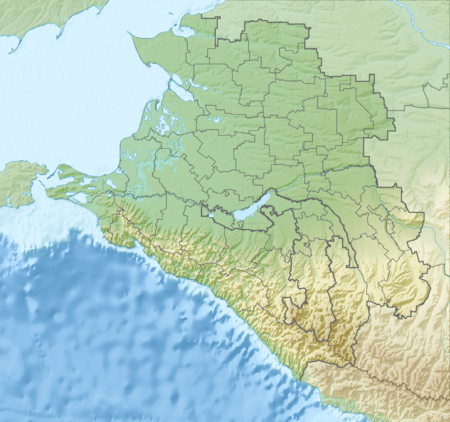
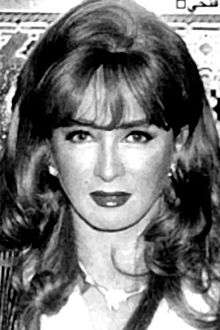



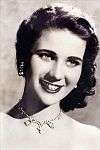



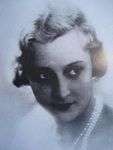



.jpg)

.jpg)
